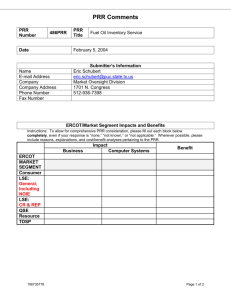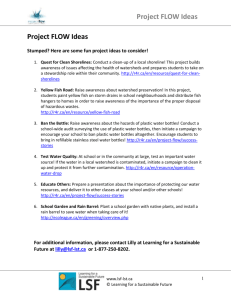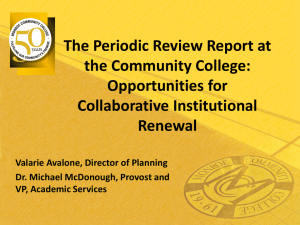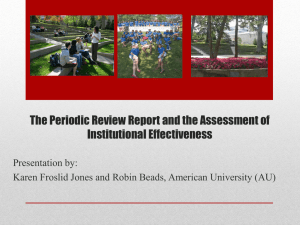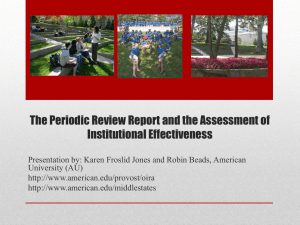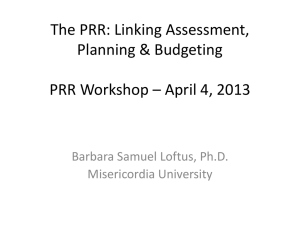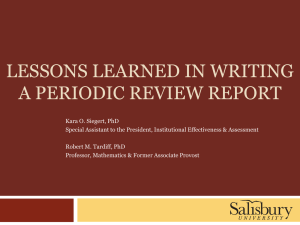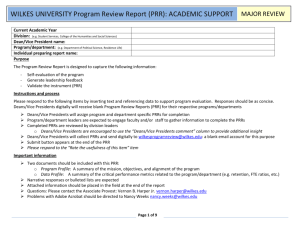Peer-Reviewed Research (PRR) – What Effect on FAPE
advertisement
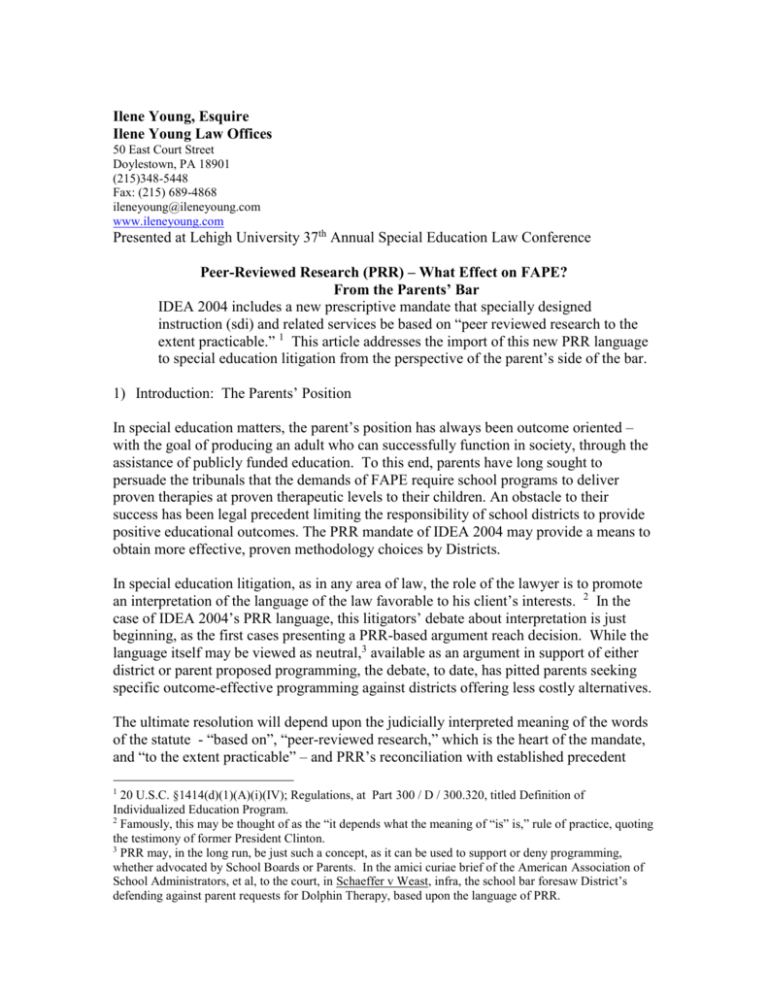
Ilene Young, Esquire Ilene Young Law Offices 50 East Court Street Doylestown, PA 18901 (215)348-5448 Fax: (215) 689-4868 ileneyoung@ileneyoung.com www.ileneyoung.com Presented at Lehigh University 37th Annual Special Education Law Conference Peer-Reviewed Research (PRR) – What Effect on FAPE? From the Parents’ Bar IDEA 2004 includes a new prescriptive mandate that specially designed instruction (sdi) and related services be based on “peer reviewed research to the extent practicable.” 1 This article addresses the import of this new PRR language to special education litigation from the perspective of the parent’s side of the bar. 1) Introduction: The Parents’ Position In special education matters, the parent’s position has always been outcome oriented – with the goal of producing an adult who can successfully function in society, through the assistance of publicly funded education. To this end, parents have long sought to persuade the tribunals that the demands of FAPE require school programs to deliver proven therapies at proven therapeutic levels to their children. An obstacle to their success has been legal precedent limiting the responsibility of school districts to provide positive educational outcomes. The PRR mandate of IDEA 2004 may provide a means to obtain more effective, proven methodology choices by Districts. In special education litigation, as in any area of law, the role of the lawyer is to promote an interpretation of the language of the law favorable to his client’s interests. 2 In the case of IDEA 2004’s PRR language, this litigators’ debate about interpretation is just beginning, as the first cases presenting a PRR-based argument reach decision. While the language itself may be viewed as neutral,3 available as an argument in support of either district or parent proposed programming, the debate, to date, has pitted parents seeking specific outcome-effective programming against districts offering less costly alternatives. The ultimate resolution will depend upon the judicially interpreted meaning of the words of the statute - “based on”, “peer-reviewed research,” which is the heart of the mandate, and “to the extent practicable” – and PRR’s reconciliation with established precedent 1 20 U.S.C. §1414(d)(1)(A)(i)(IV); Regulations, at Part 300 / D / 300.320, titled Definition of Individualized Education Program. 2 Famously, this may be thought of as the “it depends what the meaning of “is” is,” rule of practice, quoting the testimony of former President Clinton. 3 PRR may, in the long run, be just such a concept, as it can be used to support or deny programming, whether advocated by School Boards or Parents. In the amici curiae brief of the American Association of School Administrators, et al, to the court, in Schaeffer v Weast, infra, the school bar foresaw District’s defending against parent requests for Dolphin Therapy, based upon the language of PRR. PRR Parents position Ilene Young, Esquire Page 2 of 10 limiting the responsibility of Districts for producing positive educational outcomes – the Rowley-based precedents. 2) Rowley-based Precedents Twenty-two years ago, in Hendrick Hudson Central School District Board of Education v Rowley (Rowley), the Supreme Court 4, interpreting, for the first time, the Education for All Handicapped Children Act 5(EHA), the precursor to IDEA, held that FAPE requires, not the maximization of potential for children with handicaps, but merely access to the public schools and the provision of “educational benefit.” The case concerned a student with hearing loss, who was progressing through the regular academic curriculum as an A student. Through her parents, she was requesting sign language. Her request was denied.6 , 7 “We therefore conclude that the "basic floor of opportunity" provided by the Act consists of access to specialized instruction and related services which are individually designed to provide educational benefit to the handicapped child.”458 U.S 201 Approximately three years following Rowley, some courts began expanding upon this standard. In 1985, the fourth circuit found that Rowley allowed courts to make case by case evaluations of the FAPE benefit standard in Hall v Vance County Board of Education8. The court based its opinion on the following self-limiting language from Rowley:9 “We do not attempt today to establish any one test for determining the adequacy of educational benefits conferred upon all children covered by the Act. Because in this case we are presented with a handicapped child who is receiving substantial specialized instruction and related services, and who is performing above average in the regular classrooms of a public school system, we confine our analysis to that situation.” Rowley, supra, at 202. In 1988, the Third Circuit held that FAPE requires special education to be reasonably designed to produce actual progress, not ‘trivial educational advancements.”10 4 Board of Education of the Hendrick Hudson Central School District v Rowley, 458 U.S. 176, 1982 PL 94-142 6 The District had contended that a teacher speaking loudly would suffice. 7 Rowley also established the principal that courts could not substitute their judgment for that of the public schools. Districts need not maximize potential nor employ specific methodologies. Blackmon v Springfield R-XII School District 198 F.3d 648, 658-59 (8th Cir. 1999). However, lack of progress in programming has been viewed as evidence of the inappropriateness of continuing the same programming. Johnson v Lancaster-Lebanon Intermediate Unit 13 757 F. Supp. 606 (ED Pa. 1991). 8 Hall v. Vance County Board of Education 774 F.2d 629 (4th Cir. 10/10/1985) 9 See also Carter v Florence County School District Four,510 U. S. 7;114 S.Ct. 361 (1993) 10 Board of Education of East Windsor Regional School District v Diamond, 808 F.2d 987, 99l (3d Cir. l986), Polk v Susequehanna Intermediate Unit 16 , 853 F.2d 171 (3rd Cir. 1988) 5 PRR Parents position Ilene Young, Esquire Page 3 of 10 While incorporating these modifications in some instances, reliance upon Rowley is still uniformly employed to limit the responsibilities of districts for providing positive educational outcomes to students with disabilities. The “Rowley-based FAPE standard” of ‘some benefit’ is therefore the tenet that the tribunals must reconcile with the outcome based PRR language of IDEA 2004. 3) Defining ‘Peer Reviewed Research’ a) PRR in Context At first glance, the language of IDEA 2004 appears fairly unambiguous, even more so when viewed in the context of the times. The history surrounding the reauthorization, in both the legislative and executive branches of the federal government, makes clear that the federal government wanted to encourage the development and use of scientifically based educational methodology proven to produce positive outcomes. It also makes clear that resistance, by the public school establishment, was anticipated. In October, 2001, then-President Bush established a Commission on Excellence in Special Education, which issued its findings in 2004: “Finding 8: Research on special education needs enhanced rigor and the longterm coordination necessary to support the needs of children, educators and parents. In addition, the current system does not always embrace or implement evidence-based practices once established.”11 (emphasis original) Also in 2001, The No Child Left Behind Act (NCLB) (Public Law 107-1100) was passed. NCLB emphasized using “What Works”, including the Reading First grant programs which stressed the use of scientifically based reading programming and research.12 This legislation was joined by the Education Sciences Reform Act of 200213, establishing the Institute for Education Sciences (IES) (Public Law 107–279) “ …to carry out a coordinated, focused agenda of high-quality research, statistics, and evaluation that is relevant to the educational challenges of the nation.”14 In 2004, the IES established the What Works Clearinghouse, which provides peer review and maintains a reference base of studies of the effectiveness of educational programming. 11 President's Commission on Excellence in Special Education Report: A New Era: Revitalizing Special Education for Children and Their Families, 2002, Executive Summary. http://www.ed.gov/inits/commissionsboards/whspecialeducation/ 12 EARLY READING FIRST PROGRAM Subpart B, Part B, Title I of the Elementary and Secondary Education Act of 1965 (ESEA) as amended by No Child Left Behind Act of 2001 (Updated January 22, 2007) 13 Education Sciences Reform Act 2002 http://ies.ed.gov/pdf/PL107-279.pdf 14 U.S. Department of Education Publication Number 2003060d, “Federal Programs for Education and Related Activities,” http://nces.ed.gov/pubs2003/2003060d.pdf PRR Parents position Ilene Young, Esquire Page 4 of 10 “The mission of the Institute of Education Sciences’ (IES) “What Works Clearinghouse” is to be a central and trusted source of scientific evidence for what works in education.”15 It was within this climate that the PRR language of IDEA 2004 was drafted, and the understanding of the impact this language would have on due process litigation was the subject of contemporaneous commentary. Following closely upon the reauthorization, briefs were submitted in Schaeffer v Weast, 546 U.S. 49 (2005). An amici curiea brief on behalf of the Pennsylvania Association of School Administrators, among others, records the School District bar’s interpretation of PRR as it would be addressed in IDEA due process litigation. This brief, arguing against placing the burden of proof on Districts, was jointly submitted by several powerful national school district organizations. It makes clear their belief that the opinions of teachers and administrators concerning programming efficacy would not be enough to meet the PRR standard in a due process hearing but, rather, direct expert testimony concerning the underlying peer reviewed research for a given therapy would be required: “Perhaps most troubling, under revisions made to IDEA 2004, the special education and related services provided in an IEP must be “based on peerreviewed research to the extent practicable.” 20 U.S.C. § 1414(d)(1)(A)(i)(IV) .…School Districts will not only have to present expert testimony demonstrating the adequacy of their proposed therapies based on peer reviewed research, but as a practical matter, they may often be forced to hire additional experts who are qualified to question the appropriateness of the therapies proposed by parents’ experts. Because so many different types and degrees of disabilities are found in the student population, and new and untested therapies are constantly emerging, schools will be forced to rely on a myriad of experts in different fields of therapy… In cases like these, IDEA’s new emphasis on peer-reviewed research means that expert testimony will increasingly take center stage(.)”16 In Commentary to the IDEA 2004 Regulations 17, which addresses the comments and concerns, about IDEA 2004, of interested parties from both sides of the parent-district divide, extensive discussion is addressed to the issue of the language of PRR and proposed alternatives. Requests to characterize the PRR requirement by alternative language such as “best practices” or “evidence based practices,” were specifically rejected because they do not necessarily, by definition, meet the standard of PRR.18,19 “What works clearinghouse: U.S. Department of Education Institute of Education Sciences”, http://ies.ed.gov/ncee/wwc/reports/Topic.aspx?tid=01 16 Schaeffer v Weast, Brief of the Council of the Great City Schools, American Association of School Administrators, National Education Association, Pennsylvania Association of School Administrators, National Association of Elementary School Principals, Public School Superintendent’s Association of Maryland, and Connecticut Association of Public School Superintendents as amici curiae, United States Supreme Court, No. 04-698; Pamela Harris, Esq, and Shannon Pazur, Esq 17 34 CFR Parts 300 and 301 18 46665 Federal Register / Vol. 71, No. 156 / Monday, August 14, 2006 / Rules and Regulations 15 PRR Parents position Ilene Young, Esquire Page 5 of 10 Requests for a specific definition of PRR to be included in the regs resulted in the following response: ‘‘Peer-reviewed research” generally refers to research that is reviewed by qualified and independent reviewers to ensure that the quality of the information meets the standards of the field before the research is published. However, there is no single definition of ‘‘peer reviewed research’’ because the review process varies depending on the type of information to be reviewed.”20 b) PRR as Defined in the Field and the Law While it may be true that the precise definition of PRR varies depending upon the type of information to be reviewed, as suggested by the Commentary, supra, it does not therefore follow that interpreters of PRR language in IDEA 2004 must disregard the established meaning of the terms within the fields of education and law. Defined acceptable standards for peer-review can be found in many areas of the field of education science. For example, the Department of Education What Works Clearinghouse has established a standard for peer review of research studies of education methodology, which relies upon replicable, controlled, properly designed experimentation. 21 Similar protocols have been established by grant review provisions included in NCLB, IDEA 2004 and other federal education legislation. Education departments of major universities have established research protocols, as have all scholarly journals in the field.22 In the Federal Courts, peer-reviewed research has been defined and redefined in various matters ranging from intellectual property disputes to, notably, the recent Pennsylvania case of a school board seeking to insert the theory of intelligent design into the science curriculum, over the objection of parents and teachers23: “(P)eer review involves scientists submitting a manuscript to a scientific journal in the field, journal editors soliciting critical reviews from other experts in the field and deciding whether the scientist has followed proper research procedures, employed up-to-date methods, considered and cited relevant literature 19 Although see Souderton Area School District v J.H, 2009 U.S. Dist LEXIS 10781 (E.D. Pa. March 2009), wherein it appears that best practice satisfies the PRR requirement. 20 46665 Federal Register / Vol. 71, No. 156 / Monday, August 14, 2006 / Rules and Regulations 21 WWC Procedures and Standards Handbook Version 2.0 – December 2008, http://ies.ed.gov/ncee/wwc/references/idocviewer/doc.aspx?docid=19&tocid=1. 22 An example of standards : American Educational Research Association. http://www.aera.net/uploadedFiles/Publications/Journals/Educational_Researcher/3506/12ERv35n6_Stand ard4Report%20.pdf 23 Kitzmiller v. Dover Area Sch. Dist., 400 F. Supp. 2d 707 (M.D. Pa. Dec 20, 2005). Interestingly, the proponents of Intelligent Design and irreducible complexity argued that their theories were supported, in part, by bits and pieces of science, cobbled together in an “eclectic” fashion. PRR Parents position Ilene Young, Esquire Page 6 of 10 and generally, whether the researcher has employed sound science.” Kitzmiller at 744-745 It is reasonable to presume the commonly accepted meaning of PRR to be the meaning of the PRR language of IDEA 2004. 4) To The Extent Practicable. In Black's Law Dictionary the word practicable is defined as "that which is performable, feasible, possible." 24 In common usage, in law, ‘practicable’, as used unmodified in the context of the phrase found in IDEA 2004, would translate to “possible’, meaning that the use of methodology based upon PRR is required if it is available. 25 This interpretation is corroborated by the Commentary to the Regulations, where the issue was directly addressed: “Discussion: Section 612(d)(1)(A)(i)(IV) of the Act requires special education and related services, and supplementary aids and services, to be based on peer-reviewed research to the extent practicable. States, school districts, and school personnel must, therefore, select and use methods that research has shown to be effective, to the extent that methods based on peer-reviewed research are available.”26 5) Based On: PRR and FAPE The evident conflict between the PRR standard, the outcome based objectives of recent special education legislation policy, and the Rowley-based concept that special education need deliver no more than ‘some’ benefit, is difficult to resolve. That conflict has been evident in the few recent court cases to date in which courts have addressed claims arising from the PRR requirement, while continuing reliance on Rowley based precedent.27 In some instances the tribunals have interpreted the constraints of PRR to allow Districts to employ what is being referred to as the ‘eclectic’ approach to programming.28 These cases have largely turned upon the question of whether a given 24 Blacks Law Dictionary (8th 2004) It is noted that, where legislation intends to permit other considerations (such as cost or whether compliance would be overly onerous), the word “practicable” is generally modified by the word “reasonably” as in “ as far as reasonably practicable.” IDEA 2004 specifically does not provide this modification. See: Freedom of Information Act Federal Statute Title 5 U.S. Code,§ 552 26 46665 Federal Register / Vol. 71, No. 156 / Monday, August 14, 2006 / Rules and Regulations 27 It is rarely possible, from decisions, to know how artfully the respective parties’ positions were argued or presented, and therefore the few decisions yet available should be viewed cautiously. For more information, pleadings can be accessed through PACER. 28 Zirkel, Perry. “Have the Amendments to the Individuals with Disabilities Education Act Razed Rowley and Raised the Substantive Standard for “Free Appropriate Public Education?,” 396 J. NAALJ 282 (2008). http://www.law.seattleu.edu/Documents/aljho/resources/ZirkelFAPEArticleNAALJ.pdf 25 PRR Parents position Ilene Young, Esquire Page 7 of 10 methodology is “based on” PRR, and thereafter apply the Rowley-based minimal outcome requirements for FAPE. E.D.PA: In Souderton Area School District v J.H., 2009 U.S. Dist LEXIS 10781; (E.D.Pa. 2009), the issue of PRR was raised, for the first time, at the District Court level of appeal and had not been raised at hearing or second tier administrative appeal. The court’s opinion on the issue rested on the burden of proof, in that parents had failed to disprove the district’s contention that its programming was based on PRR. “I find that J.H. has failed to demonstrate that the IEP's writing instruction plan fails to provide a FAPE because Souderton's proposed writing instruction, the "writing process," has been identified as a "best practice" and is sufficient to satisfy the IDEA's requirements.” at 37 The court found sufficient nexus for the District writing program to be ‘based on’ PRR in testimony concerning an unpublished research article and general practices of teachers. The court also found that, despite establishing on cross examination that the District’s expert was not a special education teacher and was unfamiliar with the research underlying her opinions, Parent failed to meet its burden of proving the proposed writing program violated the PRR requirement of IDEA 2004. 29 9th Circuit: More interestingly, in the attempt to apply both PRR and a minimal “some benefit” Rowley standard, the 9th Circuit, in Joshua A. v Rocklin Unified Sch. Dist, 2009 U.S. App LEXIS 5795 (9th Cir 2009), finds an ‘eclectic’ approach, incorporating elements which were ‘based on peer reviewed research to the extent practicable”, but admittedly not programming itself based upon peer reviewed research, to meet the ‘based on’ PRR requirement of IDEA 2004. Here, the nexus between the peer reviewed research and the actual methodology implemented was weak, but sufficient for the program to be “based on” PRR. While it is difficult to reconcile this eclectic interpretation of PRR with the established meaning of a practice based on PRR in other areas of endeavor, and the demands of the scientific method in general, it represents the court’s attempt to reconcile a conservative brand of pre-PRR IDEA case law with the language of the reauthorization. (see also Adams by and through Adams v Oregon, 195 F. 3d 1141(9th Cir 2009) In language similar to Souderton, supra, the court states that, as long as the programming does not violate the PRR requirement, the District need not choose correctly when choosing programming. Interestingly, the court seems to suggest that, provided it is not proven to run afoul of the PRR requirement, a District is free to choose a program which has not been proven particularly effective. Query whether it would be free to choose one which PRR has established to be entirely ineffective or even 29 The requirement that Parents bear the burden of investigating the PRR status of programming provided by the District raises interesting questions concerning discovery, particularly of proprietary programs and research protocols. PRR Parents position Ilene Young, Esquire Page 8 of 10 of negative effect.30 This possibility, however, is undermined by the language of the Commentary to the Regulations, which interprets the “research” part of PRR as research which has shown the chosen programming to be effective. “Discussion: States, school districts, and school personnel must, therefore, select and use methods that research has shown to be effective, to the extent that methods based on peer-reviewed research are available.”31( emphasis added) S.D. N.Y.: More troubling are the possible implications of the March 2009 opinion, by the district court of New York, attempting to reconcile the minimal ‘some benefit’ standard with the scientific outcome-based rigors of programming “based on” PRR. In A.G. v Frieden, 2009 U.S. Dist. LEXIS 24887 (S.D. N.Y. March 25, 2009), Parent’s experts testified that student, who was autistic, was in need of intensive therapeutic levels of ABA therapy. The resulting decision finds that IEP programming meets the standard of being ‘based on’ PRR, although the IEP provided for it to be delivered at belowtherapeutic levels, because at therapeutic levels the named therapy is proven effective through PRR.32 District attorneys, on cross examination of Parent’s ABA expert, elicited agreement with the proposition that ‘some benefit’ would result from a less than therapeutic number of ABA hours. The court’s decision turned on the facts that: 1. ABA is undeniably based on PRR; 2. A minimal number of hours of ABA would produce ‘some benefit.” Although the decision in this case would appear to run counter to the “outcome based” goals enumerated in recent special education legislation, it is clearly an interesting approach to the reconciliation of the language of PRR with the minimal Rowley standard of benefit. 6) Conclusion The conservative ‘some benefit’ interpretation of Rowley, as applied to maintain the school district status quo, appears to be antithetical to the outcome based goals which led to the inclusion of PRR in IDEA 2004. Until such time as clarity and uniformity arises from court precedent or legislative amendment, it will be up to the litigators to attempt to forge an interpretation benefiting their clients.33 However, the Rowley decision itself, taken in toto and not in the reductionist headnote version familiar from caselaw, is not 30 This is not preposterous, given the lobbying interests for proponents of proprietary programs. Readers are directed, if politically interested, to the saga of the Reading First scandals involving Neal Bush. Similarly, the What Works Clearinghouse reports any number of studies documenting regressions in achievement resulting from academic intervention programs. 31 46665 Federal Register / Vol. 71, No. 156 / Monday, August 14, 2006 / Rules and Regulations 32 One can only hope that this version of the ‘eclectic’ approach to therapies based upon peer reviewed research is not adopted by the food and drug administration. 33 Should the end result be that districts may spend public funds on programming proven to be worthless, and individuals with disabilities are consigned to illiteracy and institutionalization for lack of appropriate education, the appropriate legal mechanisms for challenging the state may lie outside IDEA in state and federal Constitutions. PRR Parents position Ilene Young, Esquire Page 9 of 10 quite as inflexible and hidebound as it is represented to be, and may offer opportunity for argument. While Rowley is most frequently cited to limit the responsibilities of districts for providing positive educational outcomes to students with disabilities, a close reading of the opinion reveals its view of public education and children with handicaps to be firmly anchored in the historic context from which it arose. Authored by then Chief Justice Rehnquist, the majority opinion delves extensively into the legislative history surrounding the passage of the EHA, seeking to effectuate the intentions of the drafters. The overarching goal of EHA was determined to be that of opening the door of public education to children with handicaps, in direct response to past exclusionary practices of public school districts. 34 The opinion makes over twenty references to exclusion of children with handicaps from public school at the time of the passage of the EHA and just as many references to access. In this respect, the Rowley opinion is firmly within the pantheon of civil rights decisions of its era, interpreting civil rights legislation to share the privileges of civic participation with the previously dispossessed. “The Act's intent was more to open the door of public education to handicapped children by means of specialized educational services than to guarantee any particular substantive level of education once inside.” 458 U. S. 191-197. In contrast, the legislative history of IDEA 2004, discussed infra, is not concerned with mere access to public education for classes of individuals historically excluded. That hurdle has presumably been cleared. During the intervening twenty two years between Rowley and IDEA 2004, education science had developed new and more effective methodology which did not exist at the time of Rowley. The context from which IDEA 2004 arose was proficiency-standards oriented, outcome based, and inclusive. It presupposed the ability of schools, through the implementation of research based scientifically sound programming, to educate students with disabilities with a goal of proficiency. It presumed the ability of children with handicaps to learn and transition to a place in society. A focus on Rowley’s pre-IDEA notion of mere access to the school room threatens to place it firmly as an obstruction in the pathway to progress. A more progressive focus on Rowley’s reliance on historical context, fidelity to the intent of the drafters of legislation, and flexibility in case by case determination of the requirements of FAPE, allow it to be incorporated into the future of special education law. The intention to employ scientifically validated, outcome based programming in federally funded special education is clear from the surrounding historical context in which the 34 “Other portions of the statute also shed light upon congressional intent. Congress found that of the roughly eight million handicapped children in the United States at the time of enactment, one million were "excluded entirely from the public school system" and more than half were receiving an inappropriate education. * * *” Rowley, supra, at 189 PRR Parents position Ilene Young, Esquire Page 10 of 10 PRR language of IDEA 2004 was drafted. So is the resistance to federal interference in local special education practices. In 2007, the Subcommittee on Early Childhood Elementary and Secondary Education, of the U.S. House of Representatives, held hearings on the progress made in reconciling NCLB with Special Education.35 “What is alarming is that many schools and districts have not committed to evidence-based practices in order to ensure the success of all the students…Part of the answer to this rests in centuries of fear and bias, or more recently, pity and caretaking toward people with disabilities, or for that matter, any people who are different from the typical. Given recent rhetoric and position statements on NCLB reauthorization among educational organizations, it seems to me that these attitudes are institutionalized in some professional organizations, even those representing special education.” Testimony of Quenemoen, Rachael, senior research fellow, National Center on Education Outcomes. Truly effective, outcome oriented, scientifically based programming for special education is the goal of parents and students advocacy groups, both for their individual children and for our society. Despite the gloomy opinion expressed in the Congressional testimony quoted above, it is unlikely, in the long run, that this goal conflicts with that of the school districts, or of society in general. The policy question is not whether we should invest in continuing with ineffective methodology or invest in progress. The real policy question is at which stage of the lifetime of citizens do we want to invest – in a student who may one day take his or her place as a full participant in society due to an appropriate education, or later, in the lifelong costs of the aftermath of failure to educate. With this sentiment, even Rowley is in agreement.36 35 http://www.eric.ed.gov/ERICDocs/data/ericdocs2sql/content_storage_01/0000019b/80/37/11/01.pdf ; How NCLB Affects Students with Disabilities: Hearing Before the Subcommittee on Early Childhood, Elementary, and Secondary Education; Committee on Education and Labor; U.S. House of Representatives, 110th Congress, 1st Session, Hearing Held March 29, 2007, Serial No. 110-18 Serial No. 110–18; 36 Rowley, 458 U.S. at 201 n. 23, 102 S.Ct. at 3048 n. 23.” After referring to statistics showing that many handicapped children were excluded from public education, the Senate Report states: "The long-range implications of these statistics are that public agencies and taxpayers will spend billions of dollars over the lifetimes of these individuals to maintain such persons as dependents and in a minimally acceptable lifestyle. With proper education services, many would be able to become productive citizens, contributing to society instead of being forced to remain burdens. Others, through such services, would increase their independence, thus reducing their dependence on society." S.Rep. at 9. See also H.R.Rep. at 11.”
